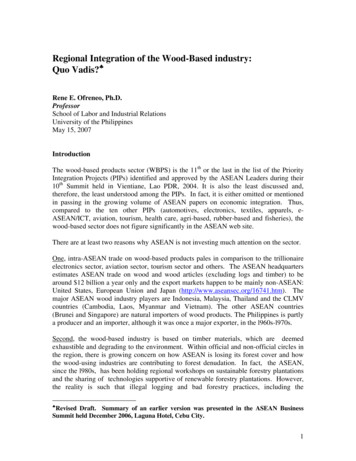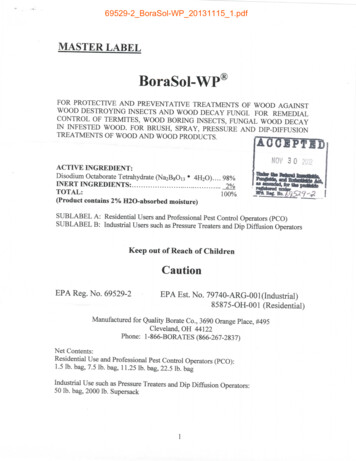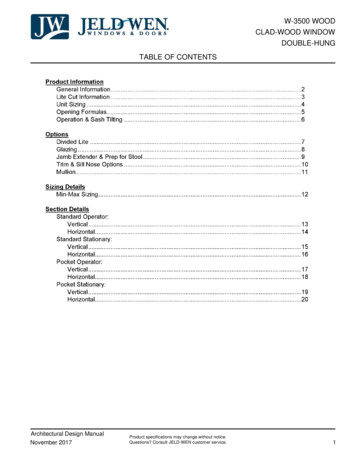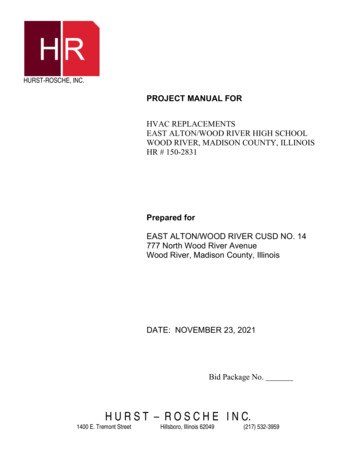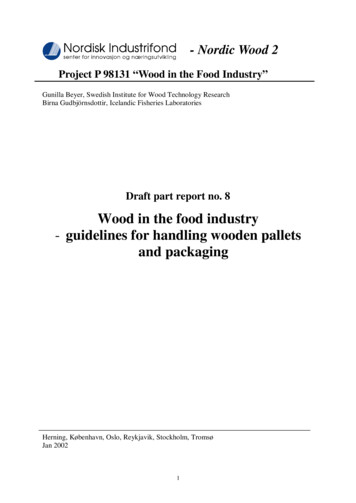
Transcription
- Nordic Wood 2Project P 98131 “Wood in the Food Industry”Gunilla Beyer, Swedish Institute for Wood Technology ResearchBirna Gudbjörnsdottir, Icelandic Fisheries LaboratoriesDraft part report no. 8Wood in the food industry- guidelines for handling wooden palletsand packagingHerning, København, Oslo, Reykjavik, Stockholm, TromsøJan 20021
ForewordWood used to be the most common material for packaging, workbenches, shelves, tools,buildings, interiors etc., in the food industry in the Nordic countries. The use of wood hashowever decreased, and other materials like plastic, concrete, stainless steel and aluminiumhave taken its place. The reason for this negative development seems to be declining marketdemands, partly caused by legislation in Europe and elsewhere.Despite this, nearly 1,5 million cubic meter of timber per year is used for pallets and packaging in the Nordic countries. These products are hence of great importance for the woodindustry as the alternative production of packaging materials may be chips for pulp production. Based on that background, a Nordic research project was initiated to find out more aboutthe behaviour of wood in contact with foodstuff.The main object of the project has been to find out basic facts about the hygienic properties ofwood and collect data regarding wood products and their substitutes when used in the foodindustry.This report is one in a series of reports where the results from the Nordic Wood 2 project no.P 98141 ”Wood in the Food Industry” are presented.This part report gives information about Hazard Analysis and Critical Control Points andGood manufacturing practice, guidelines for handling, cleaning and sanitation of woodenpallets and packaging.The project is funded by the Nordic Industrial Fund through their program Nordic Wood 2which is an R&D program for the Nordic wood industry. The Nordic timber and woodworking industry and national funding authorities in the Nordic countries have raisedadditional funding.The project has a steering group with the following members:-Dag Aasheim, chairpersonPeter JensenStefan NilssonBjarni IngibergssonOtta Sag&Høvleri ASDansk træemballage AS, DenmarkÅsljunga Pallen AB, SwedenLimtré h.f., IcelandThe research is carried out by The Danish Institute for Technology, Icelandic FisheriesLaboratories, The Norwegian Institute for Wood Technology, The Norwegian Institute forFisheries and Aquaculture and The Swedish Institute for Wood Technology Research.Representatives from food surveillance institutions in the Nordic countries are invited to theproject meetings. Pallet manufacturers, sawmills, woodworking industries and users ofwooden constructions, pallets and packaging are also involved.The participants would like to forward their warm thanks to Nordic Industrial Fund and thenational funding authorities in Denmark, Iceland, Norway and Sweden that have contributedto the funding of the project.2
This part report no. 8 is written by:Gunilla Beyer, Swedish Institute for WoodTechnology ResearchBirna Gudbjörnsdottir, Icelandic FisheriesLaboratories.Stockholm January, 2002Gunilla Beyer3
Table of contentsPageForeword2Summary5Wood in the food industry6Guidelines for handling wooden pallets and packaging6Wood in the food industry6Food hygiene11Cleaning and sanitising treatments18Conclusion24References254
SummaryWood has been a traditional material for many applications in the food industry. But today theusage of wood in the food industry is under debate and wood is getting discriminated in manysectors - in utensils, interiors and buildings as well as in pallets and packaging. The mainreasons stated are risk of splinters wood is a porous material lack of cleaning and/or sanitation methodsSince 1998 a Nordic project is going on with the aim to find out basic facts about the hygienicproperties of wood. This report will give some information about Hazard Analysis andCritical Control Points (HACCP) and Good Manufacturing Practices (GMP), some generalguidance for handling wooden pallets and packaging in the food industry and informationabout some methods for cleaning and sanitation in order that wooden pallets and packagingcan be used in the best way.Recent studies both in the Nordic countries and in Europe have shown that wood is as good asany other material for many purposes in contact with food.In order to keep a good hygiene there are some general rules for handling and storage ofpallets and packaging.Use clean, dry pallets for the food industry. Wooden pallets should not be stored unprotectedoutdoors in order to avoid biological, physical and chemical contamination.Keep pallets separated – special pallets for hygienic zonesUse pallet inverters. To avoid contamination a possible, cheap and easy solution is to usewooden pallets with a slip-sheet on top. When depalletising one pallet the receiving pallet alsohas a slip-sheet on top. The pallets can be kept in separate zones and the slip-sheets can bemade of different materials, expendable or reusable.One method to clean pallets is to use high pressure water sprinkling.The pallets can be pasteurised by using-Heat treatment by adding an additional drying cycle in a kilnHigh temperature treatmentMicrowave technology, which seem to be one very promising method. This method isused in the egg industry but need to be adjusted for other food sectors5
Wood in the food industry– Guidelines for handling wooden pallets and packagingWood has been a traditional material for many applications in the food industry. But todaywood is getting discriminated in many sectors - in utensils, interiors and buildings as well asin pallets and packaging. The main reasons stated are risk of splinters wood is a porous material lack of cleaning and/or sanitation methodsSince 1998 a Nordic project is going on with the aim to find out basic facts about the hygienicproperties of wood. This report will give information about Hazard Analysis and Critical Control Points (HACCP) and GoodManufacturing Practices (GMP) some general guidance for handling wooden pallets and packaging in the food industry information about some methods for cleaning and sanitationWood in the food industryThe reason for the negative attitude towards wood seems to be caused by the food legislationand the interpretation thereof in Europe and elsewhere.For many purposes hardwood is however accepted in contact with food. As an example,beech is used for ice cream sticks. Here the wood must be strong, feel good in the mouth andnot give any flavour to the ice cream. In addition, the wooden stick is isolating and preventsthe ice cream to melt too fast. Beech is also frequently used in cutting boards and kitchenutensils.In the American regulations hard maple or an equivalently hard, close-grained wood may beused for cutting boards, cutting blocks, bakers tables and utensils such as rolling pins,doughnut dowels, salad bowls and chopsticks /1/.There are many studies on the hygienic properties of wood, see report 1 /2/. In some recentstudies there are new results supporting that wood is not less hygienic than other materials.In a Swiss study the hygienic aspects of cutting boards made of wood (European maple, beechand oak) and polyethylene (PE) were compared in order to determine the risk of foodcontamination in household and commercial kitchen. The cutting boards were infected withEscherichia coli (E.coli) and the colony forming units were retrieved by agar contact methodsbefore and after machine and manual washing. Results showed that in very humid environment both wood and PE showed very high numbers of bacteria even after washing. Probablythe high surface moisture led to ideal conditions for microorganisms. In drier environment,significantly less bacteria were retrieved on wood than on PE. The effect is not clearlyestablished but it was observed that the porous surface of wood dries out faster than the PEsurface. Scanning electron microscopy showed that the surface of the PE boards obtained avery rough and cavernous surface after a month of intensive use. On wood these surfaces dryout quicker. A significant decrease of bacterial count was found after manual washing with6
detergent and brush followed by rinsing under warm water. The conclusion was that theresults of the experiments showed that wood is not less hygienic than PE /3/.Two scientific studies in Germany /4, 5/also showed that certain types of wood were morehygienic than plastics. In one study the survival of E.coli on different wood species and PEwere compared. When an equal number of bacteria are applied to different wood species thenumber are reduced and the speed is depending on the species. The best effect was achievedon pine. The number of bacteria were not only reduced on the surface but also to the sameextent within the wood itself /4/. The outcome of these studies were checked in field tests.The German Institute for Food Technology carried out tests in 14 companies - in the meat,dairy, vegetable and bakery sectors - with commercial wooden pallets, special hygienewooden pallets and plastic pallets. The hygiene pallet was made of pine using a special dryingmethod (patent pending). The results from the different food sectors and in total (15 000measurements) are shown in figure 1 and in figure 2.Figure 1 Bacterial count per plate - A comparison of hygiene pallets, wood pallets and plasticpallets in the meat, dairy, vegetable and bakery sector.7
Figure 2. Bacterial count on hygiene pallets, wood pallets and plastic pallets (mean values).The overall bacterial count on commercial wooden pallets made from different types of woodwas on average 15 % lower than on plastic pallets. The bacterial count on hygiene palletsmade of pine heartwood was on average only half the number compared to plastic pallets /5/.From the German studies there seem to be evidence that pine and especially heartwood ofpine is superior to other frequently used species. And the special heat-treated hygiene palletswere superior to untreated pine pallets. Beside the hygroscopic properties of wood the highcontent of extractives in certain species e.g. pine proved to have a good antibacterial effect.Temperature, moisture content and number of bacteria at infection were other factors thataffected the survival of bacteria. There was also a difference between different bacteria. Thegram-positive Enterococcus faecium could survive longer than the gram-negative E. coli onwood; the survival on plastic were longer than on wood /4/. Additional ongoing studies inGermany are soon going to be published.In the Nordic project field tests are also going on in different sectors of the food industry.Different wooden pallets (made of spruce, pine and beech) as well as gluelam (used inconstructions) with different coatings are tested and compared with other materials such aspolyethylene (PE) and stainless steel. These results will be published in a separate report butsome preliminary results are shown in this report in figures 3-6.8
Number of bacteria/cm 2100wood-pallets10plastic-pallets10-pointafter 2-monthsample timeFigure 3. Bacterial count on wood pallets and plastic pallets (mean values) after 2 months inwet and cold environment.The results from a microbiological survey on wood and plastic pallets are shown in figure 3and 4. Figure 3 shows results from pallets which were loaded with saltfish and kept for twomonths in wet (85%RH) and cold environment (0-3 C). The difference in number of bacteriaon wood and plastic pallets is a minimum with slightly less bacteria on plastic pallets. Figure4 shows similar results from pallets kept in the distribution chain in one supermarket inIceland. The environment was dry (28% RH) and warm (16 C). The number of bacteria wereslightly less on the plastic pallets (PE) and High Density PE (HDPE).Number of bacteria/cm21000100wood-palletsplastic pallets1010-pointafter 2 monthsample timeFigure 4. Bacterial count on wood pallets and plastic pallets (mean values) after 2 months indry and warm environment.9
Figure 5 and 6 show results from samples of gluelam. A set of samples with different coatingswere placed in the same warehouse as the pallets in figure 3, wet and cold environment. 1A ispainted once with acryl primer (water based) and twice with acryl painting, 1B twice withepoxy painting (water based), 2A twice with polyurethane/acrylic lacquer (water based), 3Btwice with epoxy painting (oil based) and 4A twice with decay prevention (wood preservationsurface treatment). As control samples untreated gluelam and stainless steel were used.Microbiological samples were taken every second month during 16 months. The sampleswere evaluated both for total number of bacteria and for the growth of mould and yeast.Mould and yeast were very seldom identified and those results are not presented here. Thefigure 5 and 6 show that the number of bacteria depend more on the time when the sampleswere taken then on different coatings. The untreated control sample shows however highernumber compared with treated samples and with the fewest for stainless steel.20Number bacteria Figure 5. Bacterial count on different treated gluelam and stainless steel after 16 months inwet and cold environment.201A1B2A3B4AControlStainless steelNumber bacteria/cm eFigure 6. Bacterial count at different time on treated gluelam samples and stainless steel inwet and cold environment.10
But still all the counts are very low and these samples are not in direct contact with food.From these results we can conclude that gluelam is as good as stainless steel regardingmicrobiological contamination for the use of wood in constructions under these conditions.In order to use wood in the food industry there are however some aspects to consider.For different sectors with exposure to various types of bacteria different solutions could beneeded. Different species and different treatments of the pallets might be necessary fordifferent hygienic requirements.Pallets and wooden packaging, such as light packaging for fruit and vegetables are made ofdifferent species. In the Nordic countries pallets and wooden packaging are predominantlymade of our softwood species spruce and pine.The following chapter will describe the main principles in the regulations to preventcontamination of food and make special notice on items regarding wooden pallets andpackaging.Food HygieneGeneral requirementsThe food producers have their regulations, routines and control systems to ensure a safeproduction. These are mainly preventive measures such as personal hygiene, selection ofmaterials, food preparation and cleaning procedures. Nutrition, humidity, temperature, pH andaerobic (or sometimes anaerobic) conditions affect the growth of microorganisms that candestroy or infect food. As an example the following is a summary of some general hygienicrequirements concerning storage and transportation from one food producer /6/. The food shall not be stored together with substances, products or utensils that can harmthe food.The storage should be under clean and closed conditions to avoid mice, insects etc.The transportation equipment - conveyors, lifting trucks, stacking equipment etc - needregular cleaning and service.Transport boxes and crates shall be clean.During transportation the food shall be protected by sealed packaging.Avoid contamination by not using loose parts for temporary repair.Wooden pallets in the food production shall be clean and in good condition without anydamage. If the pallets are dirty or contaminated these shall be removed. In the hygieniczone wooden pallets are never used.In addition there are often other requirements like modular sizes of pallets and packaging formore efficient handling /7/.HACCP - Hazard Analysis and Critical Control PointsThe food industry needs to identify hazards and critical control points in the production.These hazards could be of biological, chemical and physical nature. This chapter will shortly11
describe the main principles in HACCP. There are different systems for HACCP and hygienecertification but these are covering about the same items /8, 9/.In Denmark there is also a standard, DS 3027 /10/, for food safety. Companies which produce,handle, supply or deliver food products recognise a need to demonstrate and document acontrol system with regard to food safety. This also applies to their subcontractors. Thestandard describes the elements of a quality system based on HACCP principles. There is anattempt to make this a European standard.The standard describes the key requirements for a quality system, which enable the companyto formulate food safety policies and objectives according to HACCP principles. The standardis intended to be used in connection with product development and manufacturing within thefood industry. The standard can be applied within all sectors of the food industry - distributorsand transport companies, suppliers of packaging, equipment, raw materials and otheraccessories to the food industry. The standard can be used by all companies wishing toestablish a HACCP system for food safety.The standard containsDefinitions for control, monitoring, validation and verificationHACCP System requirements Management responsibility System requirements Document control HACCP study and planning with descriptions of raw materials and each product/ productcategory, intended use of the product, flow diagram, identification of hazards,establishment of control measures, critical control points, critical limits, monitoringsystems etc Operation of the HACCP system Maintaining the HACCP systemThe product description shall include a description of raw materials; chemical, biological andphysical characteristics; origin; delivery method; packaging and storage conditions;preparation before use. The description of each product/product category shall include rawmaterials used; chemical, biological and physical characteristics; storage and distributionconditions.Criteria for traceability of each material or product in contact with food are now underevaluation in Europe.HACCP is aiming at securing a high safety level in the production/food processing industry.HACCP must be based on routines for Quality Assurance and a hygienic environment atproduction.12
Good Manufacturing Practices (GMP)HACCP is a requirement and GMP give guidance to assure product quality and safeprocessing environment. GMP provide supporting routine control points for important areassuch as Incoming raw materials and outgoing products/articlesProcessingQuality control, test methods and documentationControl and elimination of pestsHygienic design and maintenanceCleaning and disinfectionPolicies and educationRegarding the industry premises for food processing the following points are mentioned in thefood legislationThe construction, design, equipment and interiors of the food premises shall protect against accumulation of dirt, toxic materials, debris, undesired mould etc prevent cross contamination prevent pest contamination e g from verminPest controlPest control is a legal requirement for every food business and aims to prevent thecontamination of food and the spread of disease. Prevention of contamination requires eitherremoving the source or putting a barrier between the source and the food. By adopting aconcept of IPM (Integrated Pest Management) which include eliminating pests or preventingpests from entering a building it's possible to attain Good Manufacturing Practices (GMP).IPM is a decision making process which requires Proper identification of the pest(s) or damage caused by the pest and location of theinfestation(s) through inspections and monitoring. Specification of tolerance levels for pests Application of IPM strategies to solve the problem Verification that the IPM process is functioningAccording to Holmberg and Walling /11/ IPM may be linked with HACCP as shown infigure 7.13
Figure 7. The HACCP-principles linked to IPM /11/.In order to keep a good hygiene there are some rules for handling and storage of pallets andpackaging.Hygiene aspects on wooden pallets and packaging in the food industryPallets, cases, cardboard boxes, trays, sacs etc shall be stored to prevent contamination andfacilitate cleaning.Pallet can during outside storage be contaminated. Birds, rats, mice and highly mobile insectsare example of possible sources for contamination or transmission of microorganisms. Clean,dry pallets should be used in the food industry. Wooden pallets should not be stored unprotected outdoors in order to avoid biological, physical and chemical contamination, seepicture 1-4 /13/.14
Picture 1 Microbiological and physical hazardsPicture 2 Physical and chemical hazardsPicture 3 Quality problem15
Picture 4 Don't store pallets outdoors. Don't stack pallets directly upon each other - put sticks(skids) between the unit loadsBut there are also other factors influencing the quality and hygiene of pallets and packaging.As said before nutrition, humidity, temperature, pH and aerobic (or sometimes anaerobic)conditions affect the growth of microorganisms that can destroy or infect foodTemperature has an influence on the survival of bacteria. A general temperature scheme forprevention or killing microorganisms is shown in figure 8. 130 C 120 C 110 CDangerzone 100 C 90 C 80 C 70 C 60 C 50 C 40 CAll microorganisms and their spores are killedAutoclavingAll microorganisms are killed, endospores are notaffectedBoilingPathogens are killedSlow multiplication of microorganismsMicroorganisms are multiplied rapidly in room and 20-50 C dangerous zone forhuman temperaturefood stuff 30 C 20 C 10 C 0 C-10 C-20 C-30 CCool storageFreezing storageDeep freezingFigure 8 shows the influence of temperature on microorganisms.The quality of the wooden pallets is also important. The quality control must secure goodtrimming of the boards and planing of deckboards is a possibility even if the friction is not asgood as for sawn timber. Nailing must be checked – there shall be no protruding nails.16
The moisture content of wood has a great influence on the survival and growth of microbes.Below the fibre saturation point (u 27%) there is no free water in the cells, which makes itmore difficult for microorganisms to survive. A general rule has been that wood shall havemoisture content below 20% to avoid growth of mould and fungi. The same goes for bacteria.The higher moisture content the better survival of the bacteria. Therefore pallet should bestored under controlled conditions.One way to get a water-repellent effect is to treat the timber with a waz emulsion, which is afairly simple and inexpensive method, se report 5 /12/.Regarding meat and seafood products it's said that wooden pallets can only be used fortransportation of packed products.Where required there shall be space for storage of food and packaging and devices for loadingand unloading. Pallet inverters should be used, see figure 9.Some foodstuffs are also very sensitive to deterioration in taste by odours. Therefore steelpallets have lately been discussed for food transportation.To avoid contamination a possible, cheap and easy solution is to use wooden pallets with aslip-sheet on top. When depalletising one pallet the receiving pallet can also has a slip-sheeton top. The pallets can be kept in separate zones and the slip-sheets can be made of differentmaterials, expendable or reusable.Figure 9. Pallet Inverter should be used for good hygiene /13/.Hygienic DesignThe basic requirements on hygienic design can be summarised as Free flow of products in the process - no standstill zones Easy to maintain and clean equipment, possible to kill microorganisms on materials The product shall not be contaminated from surrounding environment or crossingproduction lines Easy inspection of equipment and validation towards requirements.In the production area the process flow shall be as straight as possible with separation of cleanhygienic zones, as exemplified in figure 10. The flooring shall be non-slippery, non-porous,easy to clean and sanitise and with drainage holes to prevent water pools. The walls shall be17
smooth and resistant to damage. Roofing shall be smooth, not keep moisture and flake off.Light fittings shall be secured.The interpretation has caused problems for the Fisheries in Norway where wooden buildingsto a large extent shall be replaced by concrete buildings.For the Fisheries on Iceland, it is approved to use untreated gluelam in the roof but in thewalls usually 1m of concrete is used and then coated gluelam above that. Acryl coating(waterbased) on the gluelam is often used in the buildings today. And as seen from theIcelandic tests (figure 5 and 6), a satisfactory hygienic environment is achieved usinggluelam.AvfallshanteringVaruintagOren zonLagringhantering- råvarorRen Lagringfärdig produktUtlastningFigure 10. Example of a food plant with one section for unloading /goods reception and partof the production and one hygienic zone for processing, packaging, storage and transportation out from the plant /13/.Cleaning and Sanitising TreatmentsCleaning shall remove microbes or materials that can cause contamination or be a potentialsite of pests.Packaging and packaging materials are factors to consider and control in order to minimisecontamination (physical, chemical and microbiologic) of the food. Hygiene pallets arerecommended in hygiene zones. Often the recommendation has been to use plastic palletswith regularly cleaning. The above recent studies have shown that plastic pallets are often notmore hygienic than pallets of other materials. Old, scratched, rough surfaces of plastic palletscan host microorganisms and are often difficult to clean properly. Wood is under manycircumstances as good as other materials for usage in the food industry.Common cleaning methods are manual cleaning, water rinsing, high-pressure water treatment,foam cleaning, steam or automatic machines. There are many types of cleansers anddisinfectants dependent on materials, types of contaminants or microbes. The criteria for18
materials and surfaces are often that the materials shall not be toxic or absorbing but resistantto detergents.For wooden pallets and packaging there are some methods to consider and then thepossibilities for using wood are much better.Heat treatmentMicrobes have their optimum temperature. Heat treatment is one way to kill microbes but thetemperature needed can vary depending on the type. In the Nordic project both typicalbacteria from different food sectors, especially the fisheries, as well as gram positive cocci,gram negative rods and gram positive spore forming bacteria, similar to those found in themeat industry, are studied.Heat treatment - tested on 19 materials wood, plywood, waxed wood, stainless steel andplastics - at 100 C for bacteria normally found in cod and 75 C for bacteria (Halobacteriumsalinarium) from saltfish is sufficient to obtain an acceptable hygienic level, se Reportnumber 7 /14/. Heat treatment can be used for different wood utensils as well as for pallets.Kiln dryingKiln drying is a form of heat treatment, which can be sufficient for certain purposes. Thefollowing is an example from a producer of protein with severe requirements on the hygienicquality of the pallets. In the Nordic countries the sawn timber is generally kiln dried. Thepallet manufacturer dries the timber in an ordinary kiln to a moisture content of 16-18 %. Thepallets are manufactured and stored either in a tent or under roof. The day before delivery tothe protein producer the pallets are kiln dried once more in a regular drying cycle, transporteddirectly out to a lorry and further to a conditioned storage room at the protein plant. Samples for total count and number of colonies of mould and yeast - are taken from each batch ofpallets for quality control. For this industry the procedure with two cycles in the kiln worksatisfactory /15/.Another possibility is High Temperature (HT) drying with temperatures up to 110-115 C/16/. So far these HT kilns are not widely used yet in the Nordic countries. But experimentswith HT drying of spruce have shown good results regarding the wood properties and an endstep with high temperature is one way to pasteurise the wood.WashingOrdinary water rinsing can sometimes be sufficient to clean the palletsHigh pressure water rinsing is a cheap and efficient method and can efficiently remove dirt aswell as bacteria, which can be seen from the Nordic study in the field tests. Figure 11 showsthat cleaning with high pressure cold water is very efficient. Microorganisms were notdetected on the pallets after cleaning except on plastic pallets made of polyethylene (PE) butthe number was very low. According to guidelines used at IFL for surface in direct contactwith food this is acceptable. The limit for “acceptable” is 5CFU/cm2 or below. The HD PEpallets tested were new pallets directly from the plastic pallet manufacturer. The tests on thePE pallets on the other hand were made on pallets already in use in the food industry.19
2 monthnumber of bacteria/cm 21000a. hHT driedsprucePEHD PEsamplesFigure 11. Effect of cleaning wood and plastic pallets using high pressure (180 bar) coldwater treatment.Steam-heatingBrushing in combination with hot steam or hot water sprinkling with dispersion of water inmicro droplets (the same system as for fire protection where you want to avoid damage fromtoo much water sprinkling) is a method that also can be used on pallets and packaging.Super steam pasteurisation -Electro Thermic Bacteriolysis (ETB) processThe Electro Thermic Bacteriolysis (ETB) process was invented for the animal killingindustry. Up to 9
This part report gives information about Hazard Analysis and Critical Control Points and Good manufacturing practice, guidelines for handling, cleaning and sanitation of wooden pallets and packaging. The project is funded by the Nordic Industrial Fund through their program Nordic Wood 2 which is an R&D program for the Nordic wood industry.


